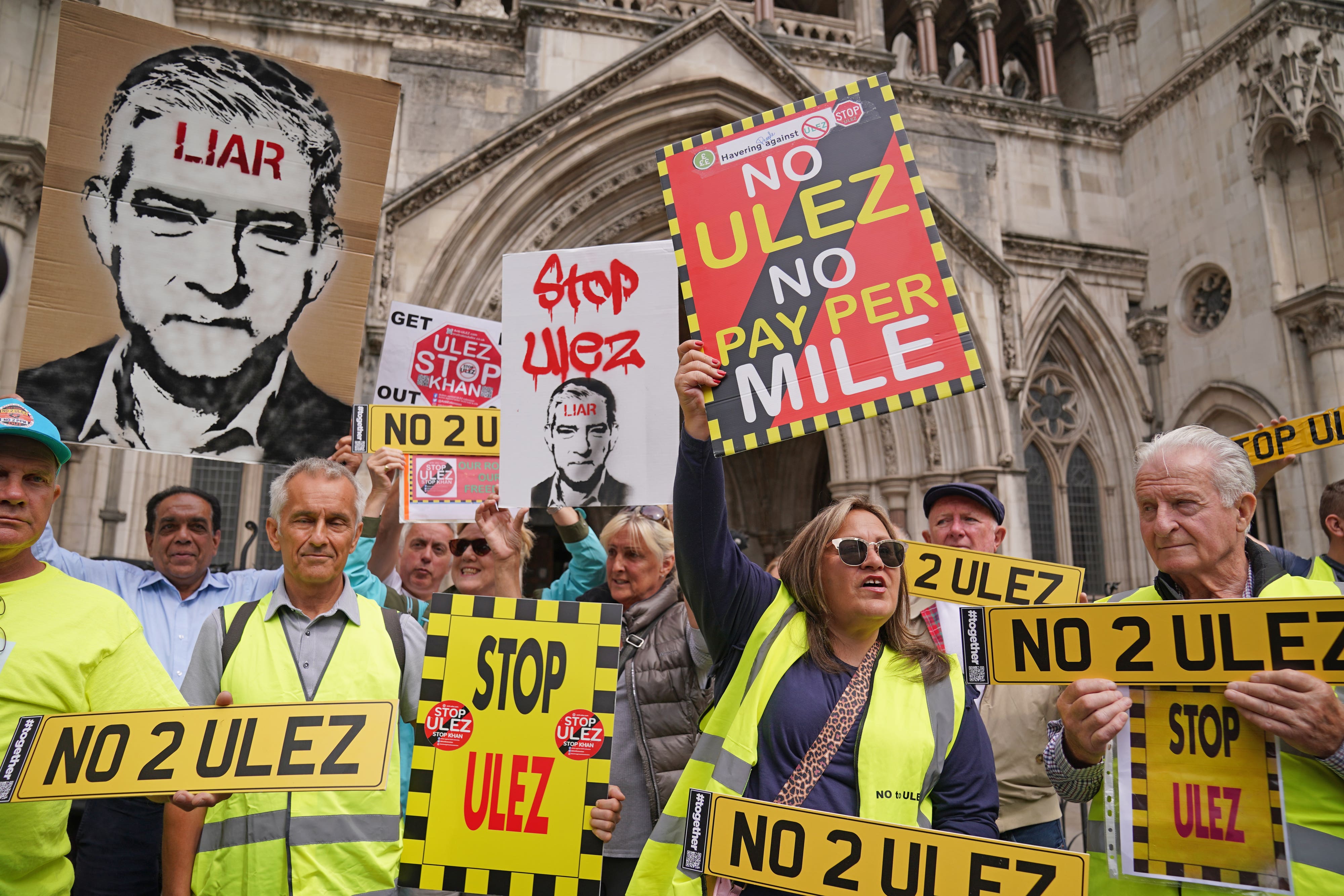London Mayor lacks power to order Ulez expansion, councils tell High Court
Five Conservative-led local authorities are challenging Sadiq Khan’s plans to extend the Ultra Low Emission Zone.

The Mayor of London lacks the legal power to order the expansion of the capital’s Ultra Low Emission Zone (Ulez), a group of Conservative-led councils have argued at the High Court.
The outer-London boroughs of Bexley, Bromley, Harrow and Hillingdon along with Surrey County Council also claim there was an “unfair and unlawful” approach to collecting views over Sadiq Khan’s proposals to enlarge the zone beyond the North and South Circular roads.
Lawyers for the local authorities taking legal action against the mayor’s plans told a judge that “key information was not disclosed” during previous consultation.
Mr Khan’s legal team reject the bid to quash his November 2022 decision to extend the Ulez to all of London’s boroughs, arguing the move is “entirely lawful” and that “ample information” was provided for a “fair consultation”.
If it goes ahead, the extended Ulez will see drivers in outer London pay a £12.50 daily fee from August 29 if their vehicles do not meet the required emissions standards.
The new borders will reach Buckinghamshire, Essex, Hertfordshire, Kent and Surrey.
At a hearing in London on Tuesday, Craig Howell Williams KC, for the councils, said the mayor’s approach is to create a “master charging scheme” for London.
It is beyond Mr Khan’s powers to introduce the Ulez charge to an outer London zone about three times the size of the current inner London area by varying existing regulations, the barrister said in written arguments.
He added that “expected additional revenues” from the expanded scheme are an “expected surplus £200 million in the first year of operation”.
Mr Howell Williams said the mayor and Transport for London’s (TfL) approach would “bypass” legal “safeguards” which were “designed to ensure that any new ‘charging scheme’ is properly considered before coming into effect”.
The councils’ barrister said material provided when gathering views on the plans was “unintelligible”, gave a “confused picture”, and meant people had to perform “a form of linguistic gymnastics or paper chase in relation to information which was central to TfL’s assessment”.
Those consulted were not told how TfL calculated there was an estimated 91% compliance rate in outer London of vehicles meeting the Ulez standards, a figure used for a “reference case” or scenario where the Ulez proposals were not implemented, Mr Howell Williams said.
As a result, “intelligent responses were prevented”, Mr Howell Williams said, such as comments on whether it was “sufficiently robust” to use data from only 106 automatic number plate recognition (ANPR) cameras in the outer London zone.
The barrister also said the mayor’s plans for a £110 million scrappage scheme – to provide grants supporting the scrapping of non-Ulez compliant vehicles – were also unlawful because a “buffer zone” for “non-Londoners” affected by the extended charging zone was not considered.
Ben Jaffey KC, representing the mayor and TfL – an interested party in the case – said in written arguments that the “primary objective” of the Ulez expansion is “to improve London’s air quality, in particular reducing nitrogen oxides (NOx) and particulates”.
The barrister said Mr Khan’s decisions “will help to get London’s air quality closer to legal limits, where they are exceeded, and World Health Organisation guideline levels everywhere”.
It would be bizarre if orders could not be amended to improve emissions standards as required
The mayor has used his powers to order changes to emissions zones rules in London on many occasions over the last 16 years.
“It would be bizarre if orders could not be amended to improve emissions standards as required,” the lawyer said, adding that “one might expect it to have come up before now”.
Mr Jaffey went on: “The consultation materials were clear, detailed and provided more than ample information to enable an intelligent response and satisfy the requirements of fairness for consultations.”
He later added: “Further, the scale of the information provided was enormous. There were hundreds of pages of detailed consultation material, including the outputs and explanation of complex modelling and detailed analysis of impacts.”
Mr Jaffey said the use of ANPR camera data was “one of several different inputs into a complex model of compliance rates, traffic, emissions and air quality”.
The barrister said TfL had been “clear” that camera coverage was “not comprehensive” and that for “full enforcement” it would install 2,750 more cameras.
“TfL provided more than sufficient information to enable an intelligent response on how it had forecast the compliance rates,” Mr Jaffey added.
The lawyer said Mr Khan had “personally considered” the level of funding available for the scrappage scheme and had “rationally” concluded it would mitigate some of the Ulez expansion impact, the court was told.
Mr Jaffey said: “Where there are finite public funds, if there are good reasons for giving preference to Londoners, that inevitably means not giving others the same benefit. These are discretionary public spending decisions.”
He added that the Greater London Authority has “very limited funds over which there are many competing demands” and said “people and businesses within Greater London are generally less able to avoid the charge from the expanded Ulez than those outside Greater London”.
A group of placard-waving outer London residents opposed to the Ulez expansion protested outside the court amid Tuesday’s proceedings.
The hearing, before Mr Justice Swift, is due to conclude on Wednesday and the judge is expected to give his ruling at a later date.
